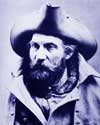MENU
Recommendations for
Further Reading
Parks and People
Evolution of a National Park Concept
Wildiands Designated...But Vulnerable
|
National Park Service: The First 75 Years
Evolution of a National Park Concept |

|
Parks and People:
Preserving Our Past For The Future
by Barry Mackintosh

Yosemite Rangers, Yosemite Valley meadow,
1915.
Evolution of a National Park ConceptThe diamond anniversary of the National Park Service is an ideal opportunity to examine the evolution of this government bureau established in 1916 to manage the national park system. Clearly, however, the Park Service cannot be understood apart from the park system. Indeed, its story must begin with the parks that preceded it and prompted its creation.
Harry Yount.
(biography)The concept of large-scale natural preservation — the "national park idea" — has been credited to the artist George Catlin. On a trip to the Dakotas in 1832, he worried about the effects of America's westward expansion on American Indian civilization, wildlife, and wilderness. They might be preserved, he suggested, "by some great protecting policy of government...in a magnificent park.... A nation's park, containing man and beast, in all the wild[ness] and freshness of their nature's beauty!"
Catlin's vision found partial expression in 1864, when Congress donated Yosemite Valley and the Mariposa Big Tree Grove to California for preservation as a state park. Eight years later, in 1872, Congress reserved the spectacular Yellowstone country in the Wyoming and Montana territories "as a public park or pleasuring-ground for the benefit and enjoyment of the people." There being no state government there yet to which it could be en trusted, Yellowstone remained in the custody of the U.S. Department of the Interior as a national park — the world's first area so designated.
Congress followed the Yellowstone precedent with other national parks in the 1890s and early 1900s, including Sequoia, Yosemite (to which the state park was returned), Mount Rainier, Crater Lake, and Glacier. The idealistic impulse to preserve nature was typically joined by the pragmatic desire to promote tourism: western railroads lobbied for the early parks and built grand rustic hotels in them to boost their passenger business.
William Henry Jackson.
(biography)The late nineteenth century also saw growing interest in preserving prehistoric Indian ruins and artifacts on the public lands. Congress first moved to protect such a feature, Arizona's Casa Grande Ruin, in 1889. In 1906 it created Mesa Verde National Park, containing the dramatic cliff dwellings of southwestern Colorado. That same year it passed the Antiquities Act, a general authority for presidents to set aside "historic landmarks, historic and prehistoric structures, and other objects of historic or scientific interest" in federal custody as national monuments.
Theodore Roosevelt, president at the time, took advantage of the act to proclaim 18 national monuments before he left office. They included not only cultural features like El Morro, New Mexico, site of prehistoric petroglyphs and historic inscriptions, and Montezuma Castle, Arizona, an outstanding cliff dwelling, but also natural features like Wyoming's Devils Tower and Arizona's Petrified Forest and Grand Canyon. Congress later "promoted" Petrified Forest, Grand Canyon, and many other natural monuments to national parks.
 PREVIOUS
PREVIOUS |
TABLE OF
 CONTENTS
CONTENTS |
NEXT
 |
Top
Last Modified: Dec 1 2000 10:00:00 pm PDT
http://www.cr.nps.gov/history/online_books/sontag/sontag1.htm
![]()
.gif)

